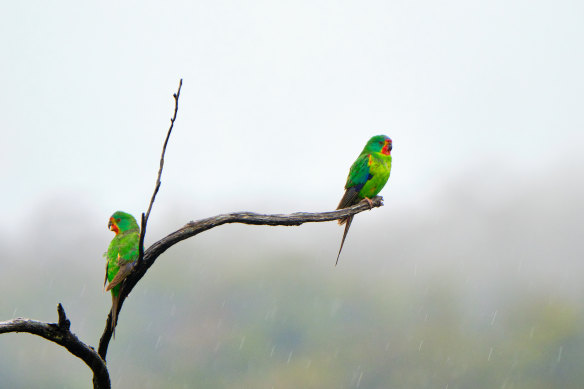
Behind this is where the new wetland centre would sit. It would house visitor and research facilities, nature and water-based play areas, a cafe and accessible walking trails. There would also be guided tours for small groups.
Wetland ecosystems are critical for supporting diverse plants and wildlife. They also have a remarkable capacity to sequester carbon despite covering less land area than other ecosystems, like forests. Over 150 species of birds have been identified at the Cheetham Wetlands, where up to 65,000 migratory waders visit in the summer.

Swift parrots are critically endangered and sometimes visit Cheetham Wetlands.
Sharp-tailed sandpipers fly in from Siberia every year, and endangered swift parrots make their way north from Tasmania. It’s also home to the endangered growling grass frogs and the rare Altona skipper butterfly, which live among the mud flats, salt marsh and eucalyptus woodlands.
The volunteers and Hobsons Bay Council, which is backing the proposal, say the centre would be an attraction for all of Melbourne, encouraging an appreciation for wetlands and the threats they face in Australia and across the globe, due to development and habitat destruction.
Wetland centres are growing in popularity in the UK, where there are almost a dozen, including one in London, and in countries like the Philippines and South Korea.
Loading
These wetlands are a stopping-off point for many bird species on the East Asian-Australasian flyway, the name given to the annual route flown by migratory shorebirds flying from and returning to their breeding grounds above the Arctic Circle in Alaska and Siberia.
The centre would be the second wetland centre in Melbourne. In the east is the Edithvale-Seaford Wetland Education Centre, which is open through bookings and sometimes on weekends.
Hobsons Bay is fortunate to have bio-diverse foreshore areas, says councillor Peter Hemphill: “The Wetlands Centre will give us the opportunity to share this incredibly special privilege with visitors from all around Melbourne.”









 Add Category
Add Category